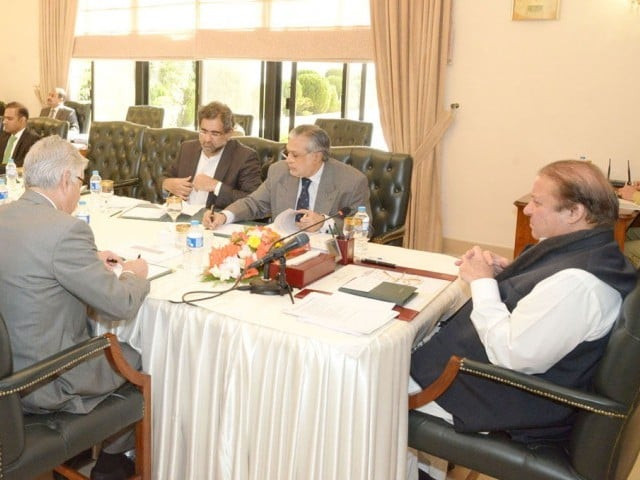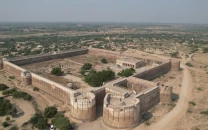Karachi power woes : Centre to seek monetary compensation from K-Electric
Cabinet blames Sindh govt and K-Electric, but action to be concentrated against utility.

PM Nawaz Sharif chairs the Cabinet Committee on Energy meeting at the PM House on Tuesday, December 9, 2014. PHOTO: PID
The federal government appears to have decided to lay the blame for the deaths caused by the recent heatwave in Karachi squarely on the doorstep of the Sindh government and K-Electric. Federal officials have resorted to false statements to augment their claims against K-Electric, as a result of which the federal government has decided to seek monetary compensation from the company.
The decision to seek compensation was taken at the June 25 meeting of the Cabinet Committee on Energy, chaired by Prime Minister Nawaz Sharif. Officials familiar with CCE’s deliberations said the National Electric Power Regulatory Authority (Nepra) had been directed to take action against K-Electric.
At the meeting, officials from the water and power ministry told the committee that K-Electric was being sold 650 megawatts of electricity from the national grid at a ‘discounted rate’. This statement is verifiably false, since K-Electric buys electricity from the state-owned National Transmission and Dispatch Company (NTDC) at the same rate as all other utility companies in Pakistan.

“We buy electricity from NTDC at the same rate as all other electricity distribution companies and we sell electricity to consumers at the rate determined by Nepra,” a spokesperson for K-Electric told The Express Tribune.
Officials from the ministry went on to say that K-Electric has idle power plants with a capacity to generate 1,100 MW. K-Electric doesn’t contest that claim but says it cannot run those power plants unless the state-owned Sui Southern Gas Company Ltd supplies it with its contractually obligated amount of natural gas to run those power plants. The government, however, appears to be ignoring K-Electric’s request for its due share of natural gas and instead NTDC has written a letter to KE asking the company to fully utilise its own power generation capacity.
A spokesperson for the Water and Power Ministry also claimed that the Council on Common Interests, a body that includes representatives from the federal and all four provincial governments, also discussed the matter and agreed to a cut of 350 MW from K-Electric’s supply from NTDC.
At the heart of the dispute is the fact that when K-Electric was privatised in 2005, it signed an agreement with NTDC to retain access to the national grid for a supply of 650 MW, an agreement that was renewed in 2008 and expired in January 2015. The government claims the contract is highly favourable to the company and wants to divert the power away from Karachi towards Punjab, where there are chronic shortages. However, it is prevented from ending its supply to K-Electric, even though the agreement expired, because of a stay order from the Sindh High Court, a decision the federal government is appealing in the Supreme Court.
Officials from the water and power ministry also told the CCE that K-Electric cut off power supply to some installations of the Karachi Water and Sewerage Board (KWSB), which aggravated the dehydration problem during the heatwave in the city. The officials pointed out that K-Electric owes several government entities such as the NTDC, SSGC, etc, over Rs130 billion but failed to mention that various government entities also owed K-Electric north of Rs131 billion.
The CCE appeared keen to make the public aware of its stance that the blame for the deaths from the heat wave lay with the Sindh government and K-Electric. Since the federal government has no power to punish provincial governments, it appears that the brunt of Islamabad’s reaction to the public anger will be borne by K-Electric.
Nepra has been ordered to initiate an inquiry against K-Electric. Preliminary findings of that inquiry have already indicated that K-Electric has not invested enough in its crumbling transmission and distribution infrastructure, though the Nepra fact-finding committee exonerated the utility in its decisions with regard to power generation.
Published in The Express Tribune, July 29th, 2015.



















COMMENTS
Comments are moderated and generally will be posted if they are on-topic and not abusive.
For more information, please see our Comments FAQ